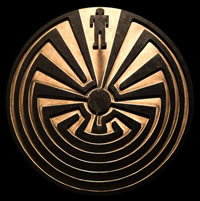The Field Experience Journal
Papers accepted for presentation at the National Field Experience Conference and other manuscripts may be submitted to Dr. Kim Creasy for review and consideration for publication in The Field Experience Journal.
Field Experience Journal Resources
Man in the Maze

The Man in the Maze is a type of unicursual labyrinth, represented in the basket making and silversmithing of the American Southwest, especially among the Tohono O’odham nation, characterized by seven concentric circles.
The twin themes of Life and Choice are commonly depicted in this type of labyrinth. The “Man in the Maze” was originally created as an illustration of the emergence story by the Tohono O’odham or Papago Indians of Southern Arizona.
The Man in the Maze has been adopted by many groups of people because of its symbolism of life’s cycles and eternal motion, and also of the choices we are confronted with. The right choices lead us to a point of harmony with all things, no matter how hard or long the road taken.
The O'odham began employing the man-in-the-maze pattern in their basketry in the early 1900s. The motif has come to serve as an icon for the O’odham people. The human-like figure is the O’odham Elder Brother, I’itoi.

